To explore the mechanism of Fuyang Jiebiao granules against viral pneumonia based on network pharmacology and pharmacodynamics
TAN Dan-dan, FENG Zhenyu, MENG Shuang, WANG Xuyan, WANG Xin-xin, ZHAO Jie,✉, ZHAO Jian-ping
1. Shanxi Univ Traditional Chinese Medicine, Jinzhong 030602, China
2. Shanxi Provincial Hospital of Integrated Traditional Chinese and Western Medicine, Taiyuan 030013, China
Keywords:
ABSTRACT Objective: To investigate the mechanism of Fuyang Jiebiao granule (FYJBKL) in the treatment of viral pneumonia.Methods: Firstly, a network model was constructed using network pharmacology to study the target expression sites of FYJBKL viral pneumonia, so as to determine the main targets and important signal transduction pathways for the treatment of viral pneumonia.Secondly, the main components of the drug and the main target are docked.Then, the fever, sweating and inflammation rat models were established to explore the antipyretic, sweating and anti-inflammatory mechanisms of FYJBKL.Finally, the contents of IL-17, IL-1β, TNF-α and IL-6 in blood samples of rats were analyzed by ELISA method,and the morphological changes of lung tissue were observed by HE staining.Results:Quercetin, luteolin, kaempferol, etc., and the main mechanism targets are IL-17, IL-1β,TNF-α, IL-6 and so on.Thirty signal pathways were identified by KEGG enrichment analysis,including interleukin-17 signaling pathway (IL-17 signaling pathway), human cytomegalovirus infection pathway (human cytomegalovirus infection), Kaposi's sarcoma associated herpesvirus infection pathway (Kaposi's sarcoma-as-sociated herpesvirus infection) and so on.After the study of molecular docking, we found that the contact efficiency between active substances and possible key targets is good.The high and middle concentration groups of FYJBKL significantly decreased the expression of IL-17, IL-1β, TNF-α and IL-6 in the blood of rats with inflammation(P<0.05).FYJBKL significantly reduced the foot swelling induced by egg white and inhibited the increase of body temperature induced by yeast in rats (P < 0.05).HE staining showed that FYJBKL improved pulmonary fibrosis and inflammatory exudation to varying degrees.Conclusion: The effects of FuyangJiebiao granules on the related signal pathways of anti-virus, anti-immune and anti-inflammation as well as biological and cellular processes may be caused by the binding of quercetin, luteolin, kaempferol and other active ingredients to their shared targets.Fuyang Jiebiao granules can improve the related symptoms caused by viral pneumonia, and its mechanism may be related to the activities of TNF, IL-17,IL-6 and other related channels, which are multiple targets of inflammation regulation.
1.Introduction
Viral pneumonia is an inflammation of the lungs caused by a respiratory virus that infects the nose and throat and then progresses downward.The outbreak of the novel coronavirus pneumonia(COVID-19) at the end of 2019 has caused enormous damage to various industries around the world.This disease has long-term latency and is highly contagious.In severe cases, it may evolve into acute respiratory distress syndrome, septic shock, kidney failure,and even death[1-2].Its clinical treatment is mainly targeted, and there is no specific drug[3].COVID-19 belongs to the category of“disease” in traditional Chinese medicine, and its main pathological mechanism is “virus invades the body and heat toxin invades the lungs” [2,4].Traditional Chinese medicine has been fighting against epidemics for thousands of years[5].The advantages of traditional Chinese medicine of “prevention before disease and prevention of disease change” have been fully reflected in the prevention and control of the epidemic[6].The combination of traditional Chinese medicine and Western medicine treatment has shortened the course of the disease and reduced the rate of mild disease to severe disease and mortality[7].Therefore, for the discovery of drugs to prevent and cure viral pneumonia, more and more scientific researchers began to focus on traditional Chinese medicine.
Fuyang Xiebiao recipe is composed of rhubarb, aconite, Zhi mother, Shengma, atractylodes, asarum, dried ginger, ephedrine,Baizhu and Sichuan pepper.It is made by Zhao Jie, founder of Fuyang in Shanxi Province, according to ephedrine Fuyang Asarum Decoction and Dajianzhong Decoction.It is based on the theory of“Fuyang Cure Disease Method”, and has the effect of warming Yang and dispelling cold, strengthening spleen and expelling turbiditis.Since the outbreak of viral pneumonia, Fuyang Jiebiao prescription has been used in high-risk groups of fever outpatient patients in our hospital with syndrome of “spleen deficiency and dampness and turbidity with heat”.It has obvious efficacy, safety and no adverse reactions.It can improve the symptoms of fever and aversion to cold in fever patients, and effectively relieve the accompanying respiratory and digestive tract clinical symptoms such as cough,shortness of breath and diarrhea.At present, the pharmacodynamic material basis and mechanism of action of this preparation are still unclear.Therefore, on the basis of previous studies, this study used network pharmacology to preliminarily explore the potential targets and related signaling pathways of Fuyang Jiebiao granules in the treatment of viral pneumonia from the perspective of molecular level, and further explore the pharmacodynamics of Fuyang Jiebiao granules through experimental verification.It provides a strong theoretical basis for the clinical application of Fuyang Jiebiao granules, and provides a new opportunity for the treatment of viral pneumonia by traditional Chinese medicine, and contributes to the modernization of traditional Chinese medicine.
2.Materials and Methods
2.1 Drug preparation
Fuyang Jiebiao granules were prepared and provided by the Pharmaceutical Products Room of Shanxi Provincial Hospital of Integrated Traditional Chinese and Western Medicine.
2.2 Active ingredient screening
CNKI, Wanfang and PubMed databases were used to study the chemical composition of Fuyang Jiebiao granules, and pharmacodynamic screening of the chemical composition of ADME process in drugs was conducted through TCM system pharmacology database and TCMSP.Ephedra, cohosh, aconite, asarum, Baizhu,rhubarb, atractyloatractyl, Sichuan pepper, dried ginger and rhizome were selected as key words, respectively.The selection parameters were set as oral bioavailability OB 30% and drug like DL 0.18.The active ingredients of Fuyang Jiepi granules were retrieved and the corresponding target genes were identified.
2.3 Target screening for viral pneumonia
Enter the keyword “novel coronavirus pneumonia” into Gene Cards database, OMIM database, Drug Bank, PharmGKB and TTD database to search for genes associated with viral pneumonia.
2.4 Identification of potential targets
Through R language, the targets found above were interlinked to obtain the potential common target, that is, the potential target of Fuyang Jiebiao granules in the treatment of viral pneumonia, and the Wayne diagram was made.
2.5 Network construction between active ingredients and potential targets
Using Cytoscape software, the selected active ingredients are combined with potential action targets to build an active ingredienttarget network.
2.6 Construction of protein interaction network PPI
Multiple Proteins in the online analysis database of STRING protein interaction were used and set as Homo sapiens, the high confidence was set at 0.400, and the potential target was saved in TSV format.Import it into Cytoscape (v3.8.2) for optimization.Network topology analysis was carried out by CytoNCA, a plugin in Cytoscape 3.8.2 software, to obtain the core target of Fuyang Jietable granules antiviral pneumonia.
2.7 Gene ontology (GO) function enrichment analysis and KEGG signaling pathway enrichment analysis
Using ClusterProfiler software r (x64 4.1.0), we studied GO enrichment and KEGG signal channel enrichment for potential action targets in 1.4, and plotted corresponding bar graphs and bubble graphs.
2.8 Molecular Docking
Using Pubchem database, we obtained the “mol2” format file of active ingredients in Fuyang Jiebiao granules.Then, we obtained the 3D structure of target proteins ACE2, MPro, PLP, IL6, MAPK1,MAPK8, TNF, AKT1, MAPK3, TP53 and PTSG2 from the RCSB PDB database.With the PyMOL software, we performed steps such as dewatering and hydrogenation of the protein, and then saved it in the “pdb” format.Next, we use the AutoDock Tools software to convert the protein and active ingredient format to the “pdbqt”format.Finally, through the Autodock-vina software, we adjusted the binding box and realized the connection between the molecule and the protein, thus obtaining the binding energy (affinity).TBtools software was used to make heat maps of molecular connections.
2.9 Pharmacodynamic experiments[8-9]
2.9.1 Animals
SPF grade Robust SD rat (Beijing Weitong Lihua Animal Technology Co., LTD.) with license number SCXK (Beijing) 2016-0011.The rats were exposed to day and night light for 12 h a day at 24 ℃, maintained good ventilation, were able to eat and drink independently, and required adaptive feeding for 7 d.In conducting this experiment, the code of ethics for test animals was strictly followed.
2.9.2 Drugs, reagents and instruments
Fuyang Jie Table granules total rhubarb, aconite, Rhizoma anemarrhenae, cohosh, atractylodes, asarum, dried ginger, ephedra,rhizoma Atractylodis Macrocephalae, Sichuan pepper 10 traditional Chinese medicine (Shanxi Weikang Tang Traditional Chinese Medicine Slices Co., LTD.,batchnumbersare200306,200207,19 0032,190034,200107,200107,190021,202001,180022,190308),egg white, Angel Yeast (Angel Yeast Co., LTD., CE2015); Aspirin(Bayer AG, J20171021); Pilocarpine (Warner Pharmaceutical Company, Sinopharm H20100117); IL-6, IL-17, IL-1β, TNF-α,ELISA kit (F3066-A, F2964-A, F2923-A, F3056-A); Castor Oil(Ketian Pharmaceutical Co., LTD., Z42020991); Commercially available iodine, starch.Electronic thermometer; Desktop high speed refrigerated centrifuge (USA Thermo Company, Centrifuge5328R),microscope (Leica Company).
2.9.3 Molding method
Thirty-five robust SD rats with SPF grade were selected and randomly divided into blank group, model group, aspirin group and Fuyang Jiebiao granule medium and high dose group.The rats were fed adaptively for 7 d before the experiment began.The medium and high dose groups of Fuyang Jiebiao granules were 2.56 g/kg and 5.13 g/kg, respectively, while the dose of aspirin group was 200 mg/kg.In the blank group and the model group, the same volume of normal saline was provided for 7 d (gavage volume was 15 mL/kg).model of inflammation: Before administration, the toe volume of each group of rats was measured as the baseline data.One hour after administration, 0.1 mL of egg white solution was injected into the base of the toes of rats in each group to cause acute inflammation of the toes of rats in each group.After the onset of inflammation, toe swelling was measured and recorded at 0.5, 1, 2, 3 and 4 h in each group to calculate the toe swelling rate (%) = ((volume - volume basis)/volume basis) multiplied by *100%.
Model of fever: The rectal temperature of each rat was measured with an electronic thermometer (before the measurement, the rats were emptied of feces to reduce errors, and paraffin was applied around the anus).When the temperature was measured, the probe was inserted 3 cm into the anus, and the sound of the electronic thermometer was heard when the temperature was stable.The rats were fasted for 12 h before the experiment, and the rectal temperature was measured once before the administration of drugs on the day of the experiment, and then again 0.5 h later.The average value of the two measurements was taken as the basal body temperature (0 h).On the second day after the end of toe volume measurement, 21g dry yeast was added to 140 mL distilled water and diluted into 15% yeast suspension.According to 10 mL/kg, 15%yeast suspension was injected subcutaneously into the lower neck of the rats in the model group, the middle and high dose Fuyang Jiebiao granule groups, and the aspirin group.The blank group was injected with 0.9% saline at 10 mL/kg.The body temperature of rats was monitored at 1 h, 2 h, 3 h, 4 h, 5 h, 6 h, 7 h, 8 h, 9 h, and 10 h after modeling (equivalent to drug administration at 2 h, 3 h, 4 h, 5 h,6 h, 7 h, 8 h, 9 h, 10 h, and 11 h).The body temperature of rats was observed, and then the difference between the body temperature and the basic body temperature at each time point was compared.Finally,after 10 h, the thermal inhibition rate was calculated.This rate =(temperature rise in the simulated group minus temperature rise in the drug group)/temperature rise in the simulated group *100%
Sweating model: Twenty-eight male SD rats were randomly divided into blank group, pilocarpine group, Fuyang Jieyu medium dose group and high dose group.The rats were fed adaptively for 7 d.The doses of Fuyang Jie surface medium and high dose groups were 2.56 g/kg and 5.13 g/kg, respectively.Pilocarpine group was given pilocarpine solution 8.75 mg/kg, and blank group was given equal dose of normal saline with gavage volume of 15 mg/kg.Before the experiment began, the rats were required to fast and not drink water for eight hours.After 30 min of administration, the rats were placed in A supine position, then the soles of the rats’ feet were wiped with a cotton swab dipped in anhydrous ethanol, followed by the application of Kotaki’s solution A.After it is completely dry,it is then coated with A layer of Hotan-Kotaki B solution (2 grams of iodine is dissolved in 100 mL of anhydrous ethanol to form Hotan-Kotaki A solution; The sweating model was reproduced by dissolving 50 grams of soluble starch in 100 mL of castor oil to form Hotan-Plateau B solution).Monitor the changes of purple spots on the feet in time, and use a macro camera to photograph and record.
2.9.4 Specimen collection
After weighing each group of rats, the rats were anesthetized by intraperitoneal injection with 10% chloral hydrate prepared with normal saline (3.5 mL/kg), then blood was drawn from the abdominal aorta and left to rest for 1-2 h after blood collection.The centrifuge is set at 3 000 revolutions per minute for 15 min, the upper level serum is collected and stored in a refrigerator at -20 ℃for later use.The lung tissue of the feverish model rat was placed in 4% paraformaldehyde solution and kept for 24 h for later use.
2.9.5 Indicator Detection The levels of IL-17, IL-1β, TNF-α and IL-6 in blood samples of rats were analyzed by ELISA.HE staining was used to detect the pathological changes in the lungs of rats.
2.10 Statistical Methods
SPSS 24.0 software was used for statistical analysis.The experimental data were all represented by “mean ± standard deviation”.One-way ANOVA was used for comparison among multiple groups, and LSD-t test was used for comparison among groups.If the P<0.05 value is less than P<0.05, it indicates that the difference is statistically significant.
3.Results
3.1 Effective components and target screening of Fuyang Jiebiao granules
Among the active ingredients we searched, 7 were white rhizome,9 were atractylodes, 16 were rhubarb, 21 were aconite, 5 were dried ginger, 5 were Sichuan pepper, 23 were ephedra, 17 were cohosh,8 were asarum, and 15 were rhizome.A total of 1 410 targets were obtained.
3.2 Targets related to viral pneumonia
In Gene Cards, OMIM, Drug Bank, PharmGKB, TTD databases,3 613, 201, 27, 95, 86 were screened, and duplicate genes were removed.A total of 3 007 target genes associated with viral pneumonia were retrieved.Figure 1
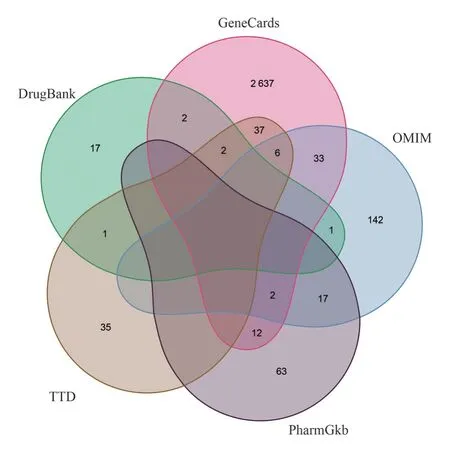
Fig 1 Relevant targets for viral pneumonia
3.3 Potential targets
114 potential targets of Fuyang Jiebiao granules in the treatment of viral pneumonia were selected.In the figure, pink represents the disease target of viral pneumonia, and green represents the target of drug active ingredients.The intersection is 114 potential targets.Figure 2
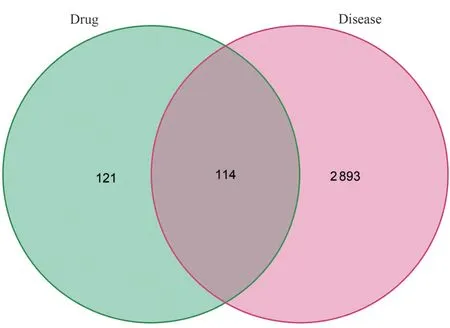
Fig 2 veen diagram of potential drug targets and disease-related targets
3.4 Active Ingredients - Potential targets
The active ingredient - a possible target - consists of 173 nodes(shown in Figure 3), each representing a specific drug product, and the connection between them is represented by a line.Composed of 456 edges, the part of the arrow symbolizes the active ingredient of the drug, while the square part symbolizes the target.The positive correlation lies in the size of the node and its degree, that is, the larger the size of the node and the font, the higher the metric.
3.5 PPI protein interaction network
The interaction diagram consists of 114 nodes and 1,928 edges,where the nodes represent proteins and the connected parts represent the interactions between these nodes (see Figure 4).There is a positive relationship between the size of the node and the depth of the color and its degree.(See Figure 5) The network structure was analyzed by CytoNCA plug-in of Cytoscape 3.8.2 software, so it is determined that the core targets of Fuyang Jiemui granules against viral pneumonia are IL6, MAPK1, MAPK8, TNF, AKT1, MAPK3,TP53 and PTSG2.
3.6 GO functional enrichment analysis and KEGG enrichment analysis

Fig 3 Active ingredient-core target network diagram
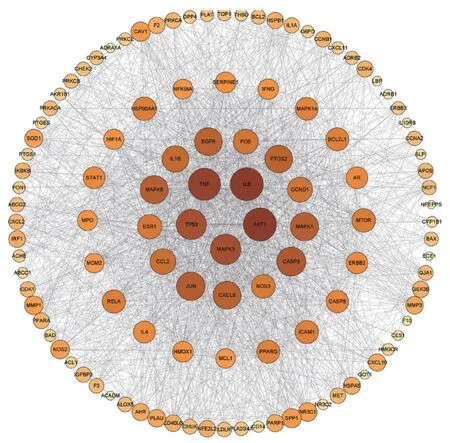
Fig 4 Protein-protein interaction network diagram

Fig 5 Core target network diagram
GO enrichment analysis is mainly aimed at three areas: biological step (BP), cell structure (CC) and molecular action (MF).In this study, the screening criteria were set up with P<0.05, and image analysis was performed on the first 10 samples.The functional cluster analysis of GO totaled 2,512 items, including 2,300 items on biological processes (BP), 154 items on molecular functions (MF),and 58 items on cell construction (CC).BP’s research focus includes lipopolysaccharide response, response to molecules from bacteria,and cellular response to chemical emergencies.The main distribution regions of CC include membrane rafts, membrane microdomains,and nuclear envelope, while MF focuses on protein serine/threonine kinase activity, DNA-binding transcription factor binding, and ubiquitin-like protein ligase binding (see Figure 6).
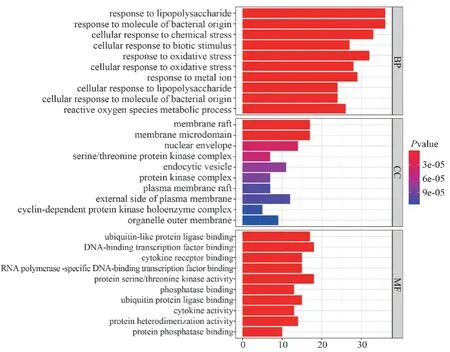
Fig 6 GO functional enrichment analysis
In the KEGG enrichment analysis, 179 KEGG pathways were found, and the first 30 pathways were selected for image analysis with P<0.05 as the screening criterion (see Figure 7).In KEGG enrichment analysis, the leading signal channels were lipid atherosclerosis, human cytomegalovirus infection channels,advanced glycation end product signaling channels in diabetes complications, herpes virus infection channels associated with Kapoo’s sarcoma, and tumor necrosis factor channels.In the image,the greater the number of bubbles, the higher the concentration of genes in the channel.Moreover, the ranking in the front may be the main biological function and mechanism of Fuyang Jiebiao granules in the treatment of viral pneumonia.
3.7 Molecular docking of active components with core targets
The binding energy of the molecular docking between the active component and the core target is less than -5 kcal/mol, so the molecular docking effect is good.See Figure 8

Fig 7 Enrichment analysis of KEGG pathway
3.8 Effects of Fuyang Jiebiao Granule on serum levels of TNF-α, IL-1β, IL-6 and IL-17 in rat inflammatory model
ELISA results showed that compared with blank group, the expression levels of serum IL-1β, IL-17, TNF-α and IL-6 in model group were significantly increased (P < 0.01).Compared with the model group, the levels of TNF-α, IL-1β, IL-17 and IL-6 factors in serum of the rat model could be significantly decreased in all drug administration groups (P< 0.01 or P<0.05), as shown in Table 1.
Tab 1 Expression levels of serum IL-1β, IL-17, TNF-α and IL-6 induced by Fuyang Jiebiao Granules in rats (pg/mL, ±s, n=7)

Tab 1 Expression levels of serum IL-1β, IL-17, TNF-α and IL-6 induced by Fuyang Jiebiao Granules in rats (pg/mL, ±s, n=7)
Note: Compared with blank group, ①P < 0.01; Compared with the model group, ②P < 0.01, ③P<0.05.
group IL-1β IL-17 TNF-α IL-6 blank group 32.90±1.65 42.95±1.48 259.62±10.33 112.11±4.59 model set 43.62±1.11① 53.83±1.92① 340.32±7.64① 134.11±7.82①Aspirin positive group 33.69±0.97② 45.65±2.02② 307.11±1.26② 114.59±7.79②FYJBKL Middle dose group 36.50±1.25② 48.79±0.81② 305.74±17.39② 123.45±8.28③FYJBKL high dose group 35.39±1.68② 46.40±1.13② 295.03±19.29② 115.85±6.49②
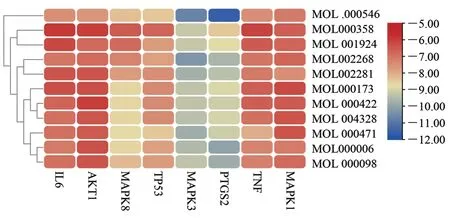
Fig 8 Molecular docking results of compounds and key targets
3.9 Effect of Fuyang Jiebiao Granules on foot swelling rate of rats induced by egg white
Compared with blank group, the swelling rate of foot in model group (0.5, 1,2,3,4 h) was significantly decreased (P < 0.01).Compared with the model control group, the swelling rate of the toe in aspirin group was significantly decreased (0.5, 1,2,3,4 h) (P<0.01 or P<0.05), but there was no statistical significance in Fuyang Jiedu medium dose group (0.5, 1,3 h), and the swelling rate of the toe in (2,4 h) was significantly decreased (P< 0.01 or P<0.05).Toe swelling rate of rats in Fuyang Jiebiao high-dose group was significantly decreased (0.5, 1,2,3,4 h) (P< 0.01 or P<0.05), the specific data are shown in Table 2.
3.10 Effect of Fuyang Jiebiao Granule on body temperature of rats induced by yeast
After yeast injection, the body temperature of the model group increased at 1,3,5 ~ 10 h compared with the blank control group, and the differences were statistically significant (P < 0.01 or P<0.05).Compared with the model group, the body temperature of the middle dose group of Fuyang Jiebao could be significantly reduced for 7~ 10 h, with statistical significance (P < 0.01 or P<0.05), and the body temperature of the high dose group of Fuyang Jiebao could be significantly reduced for 1 ~ 4,6 ~ 10 h, with statistical significance(P < 0.01 or P<0.05).The results showed that Fuyang antipyretic could significantly reduce the body temperature of yeast-induced rats at multiple time points, and had a good antipyretic effect.The results are shown in Table 3, 4
Tab 2 Effect of Fuyang Jiebiao Granules on toe swelling rate in rat(±s, n=6, %)

Tab 2 Effect of Fuyang Jiebiao Granules on toe swelling rate in rat(±s, n=6, %)
Note: Compared with blank group, ①P < 0.01; Compared with the model group, ②P < 0.01, ③P<0.05.
group 0.5 h 1 h 2 h 3 h 4h blank group 0.00±0.00 0.00±0.00 0.00±0.00 0.00±0.00 0.00±0.00 model set 52.26±15.55① 51.91±14.57① 41.00±15.66① 33.67±13.88① 25.76±10.05①Aspirin positive group 32.20±14.16③ 29.00±14.76② 14.50±9.10② 14.80±5.35② 9.76±3.73②FYJBKL Middle dose group 48.95±9.61 43.64±7.47 27.10±13.13③ 28.08±8.01 14.67±8.78③FYJBKL high dose group 17.69±11.04② 19.34±13.02② 11.85±7.63② 12.85±4.71② 6.30±5.60②
Tab 3 Temperature change parameters of rats induced by Fuyang Jiebiao Granules at 10 h (±s, n=6)

Tab 3 Temperature change parameters of rats induced by Fuyang Jiebiao Granules at 10 h (±s, n=6)
Note: Compared with blank group, ①P < 0.01; Compared with the model group, ②P < 0.01, ③P<0.05.
group 1 h 2 h 3 h 4 h 5 h blank group 0.33±0.20 -0.02±0.21 0.38±0.08 -0.06±0.05 0.19±0.25 model set -1.30±0.46① 0.16±0.46 -0.03±0.04① -0.04±0.06 0.96±0.50①Aspirin positive group -0.46±0.38② -0.17±0.31 0.30±0.06② 0.19±0.08 0.69±0.37 FYJBKL Middle dose group -1.21±0.48 -0.17±0.36 0.01±0.14 -0.27±0.28 0.42±0.22 FYJBKL high dose group -0.70±0.37③ -0.42±0.12③ -0.59±0.18② -0.30±0.08③ 0.52±0.07
Tab 4 Variation parameters of body temperature of rats induced by Fuyang Jiebiao Granules at 10 h(±s, n=6)

Tab 4 Variation parameters of body temperature of rats induced by Fuyang Jiebiao Granules at 10 h(±s, n=6)
Note: Compared with blank group, ①P < 0.01; Compared with the model group, ②P < 0.01, ③P<0.05.
group 6 h 7 h 8 h 9 h 10 h blank group 0.44±0.02 -0.06±0.13 0.12±0.11 0.11±0.29 0.31±0.12 model set 1.90±0.85① 2.41±0.62① 2.77±0.57① 2.42±0.53① 2.28±0.31①Aspirin positive group 0.28±0.17② 1.60±0.47② 1.31±0.16② 1.24±0.31② 0.96±0.24②FYJBKL Middle dose group 1.47±0.67 1.54±0.29③ 1.57±0.15② 1.56±0.28② 1.35±0.40②FYJBKL high dose group 0.78±0.17③ 1.46±0.49② 1.66±0.25② 1.51±0.32② 1.28±0.25②
3.11 Effect of Fuyang Jiebiao Granules on the inhibition rate of yeast induced fever in rats
The calculation results of fever inhibition rate showed that Fuyang Jiebei high and medium dose groups had different degrees of inhibition on yeast induced fever in rats at 5 ~ 10 h.As can be seen from Table 5, the inhibition rate of aspirin at 6 h is the highest 85.26%, while the inhibition rate of Fuyang Jiebei dose at 5 h is the highest 56.25%, and the inhibition rate of high dose at 6 h is the highest 58.95%.

Tab 5 Inhibitory rate of fever in rats(%)
3.12 Effect of Fuyang Jiebiao Granules on the secretion of perspiration on the foot and plantar-foot of rats
Table 6 shows that the number of vacuolar sweat spots in Fuyang Jiebei granule dosage groups is significantly higher than that in normal control group.Compared with pilocarpine group, the sweating effect of Fuyang Jiebei granule medium dose group is slightly worse, while the sweating effect of high dose group is similar to pilocarpine group.
Tab 6 The number of sweat spots on the plantar of the foot of rats induced by Fuyang Jiebei(±s, n=6)

Tab 6 The number of sweat spots on the plantar of the foot of rats induced by Fuyang Jiebei(±s, n=6)
Note: Compared with blank group, ①P < 0.01.
group Number of sweat spots (number)blank group 89.33±30.00 Pilocarpine group 258.33±21.50①FYJBKL Middle dose group 196.00±18.52①FYJBKL high dose group 228.33±24.68①
3.13 HE staining light microscope observation
In the normal group, the bronchial and alveolar structures of the lungs remained intact, and no inflammatory cell infiltration was observed in the lungs.In the model group, the degree of pulmonary fibrosis was higher, the thickness of alveolar wall was increased, and inflammatory cell infiltration was increased.However, in the positive group, the degree of pulmonary fibrosis was relieved, the alveolar began to expand, and the inflammatory cell infiltration in the lung interstitium did not occur, and the degree of lung tissue injury was significantly reduced compared with the model group.All drug groups were able to improve fibrosis and inflammatory exudation of lung tissue to some extent.Figure 9

Fig 9 Results of rat lung tissue
4.Discussion
The main form of viral pneumonia is an attack on the deep and middle layers of the lungs, leading to inflammation, usually in people with long-term illnesses or unhealthy immune systems.If the disease is not well controlled, it will pose a threat to life, such as the outbreak of coronavirus pneumonia.Therefore, research on new drugs to alleviate and control this disorder has become very urgent[10-13].“Four saints Hanging Shu” pointed out that “exogenous evil, typhoid fever in autumn and winter, warm disease in spring and summer, cold and warm, but there is an epidemic”, which is the traditional Chinese medicine definition of viral pneumonia.TCM has thousands of years of valuable experience in treating diseases, and has comprehensive treatment methods, such as targeted diagnosis and treatment, as well as intervention for different goals and different routes[14].Wang Yaqin et al.adjusted and improved the respiratory status of patients with viral pneumonia by using nutrition that separated three jiao and protected lung and spleen[15].Professor Zhao Jie believes that Yang is an important factor to maintain good health, the surface of viral pneumonia patients seem to have wet and cloudy virus inclusion, but in fact, the weakness of Yang is the most important reason.Therefore, Professor Zhao Jie made improvements and innovations according to the classic prescriptions of ephedrine Fuzi asarum Decoction and Dajianzhong Decoction, and based on the theory of “Fuyang cure epidemic method”, he established Fuyang Jiebiao prescription to restore Yang qi and improve the body’s immunity.
In this study, the prediction of active ingredients of drug targets through network pharmacology found that quercetin, luteolin,kaempferol and other compounds were the active ingredients with high degree value.ACE2, MPro and PLP are important targets for drug screening against SARS-CoV-2, and are one of the important molecules in the host cells infected by the virus[16-19], so molecular docking is also performed for them.Molecular docking results showed that quercetin, luteolin, kaempferol and other compounds had good binding ability with key targets.
It has been found that the core targets of Fuyang Jiemui granules in the treatment of viral pneumonia include IL6, MAPK1, MAPK8,TNF, AKT1, MAPK3, TP53, PTSG2, etc.Most of them are related to inflammation.GO enrichment analysis showed that potential targets were related to biological processes, such as oxidative stress, apoptosis, and cytokines.Cytokine storm plays an extremely important role in viral infection[20].Among them, the key inflammatory factors inducing viral pneumonia mainly include TNF-α and IL-6.In addition, changes in IL-6 indicators can be used to assess severe and critical COVID-19 types[21].MAPK1,MAPK3, and MAPK8 can also prevent COVID-19 through biological processes such as cell proliferation, differentiation,transformation, and apoptosis[22].Cox-2/PTGS2 plays an important role in the inflammatory response of multiple tissues and organs[23].In addition, in the prevention and treatment of COVID-19, Cox-2/PTGS2 inhibitors are widely used in the treatment of COVID-19[24].KEGG enrichment analysis revealed 30 signaling pathways(P<0.05), including interleukin-17 signaling pathway, human cytomegalovirus infection pathway, Kapo’s sarcoma-associated herpes virus susceptibility/infection pathway, NF-κB signaling pathway, etc.Transcription of proinflammatory cytokines is regulated by the NF-κB signaling pathway, which is a pleiotropic regulator of multiple injury-response genes[25].Toll-like receptors (TLRS) lead to an increased risk of autoimmune diseases by exploiting genetic polymorphisms in themselves[26].The immune response of the body is closely related to the abnormal T-cell receptor signaling pathway,so the T-cell receptor pathway may be one of the pathways to treat viral pneumonia[27-28].The interleukin (IL-17) family is a sensitive indicator of pulmonary inflammatory response[29].IL-17 signaling pathway, TNF signaling pathway and AGE-RAGE signaling pathway related to diabetes complications have been confirmed to be associated with SARS-CoV-2 infection[30-32].Therefore,Fuyang Jiebiao granules may act on the pathways related to antiviral and anti-inflammatory mechanisms by participating in multiple inflammatory targets, such as TNF, PTGS2 and IL-6.
In this study, different rat pathological models were established on the basis of network pharmacological analysis to further explore the improvement of Fuyang Jiebiao granules on the symptoms of viral pneumonia and the possible mechanism of action.The expression of IL-1β, IL-6, IL-17 and TNF-α in blood of rats with inflammation could be significantly reduced in the Chinese medicine group.It can improve the pathological phenomena of lung tissue, such as fibrosis and inflammatory exudation.In addition, this study selected classical animal models to investigate the anti-inflammatory, antipyretic and sweating effects of Fuyang Jiebiao, and discussed its mechanism of action, fully reflecting its overall characteristics of multi-pathway,multi-target and multi-component, providing effective scientific support for the subsequent clinical application of Fuyang Jiebiao granules.
In summary, this study analyzed the active ingredients, potential targets and related pathways of Fuyang Jiebiao granules through network pharmacology, preliminarily explored the target and mechanism of Fuyang Jiebiao granules in the treatment of viral pneumonia, and carried out research using molecular docking technology and pharmacodynamics.However, this study also has some limitations.For example, the effective ingredients of traditional Chinese medicine selected from the database are not completely consistent with those actually absorbed into the body, which needs to be confirmed by more experiments.Moreover, the core targets of network pharmacology screening still need to be further verified by experiments to clarify their mechanism of action.To provide strong support for the clinical use of Fuyang Jiebiao granules.
Authors’ contribution
Zhao Jie: Responsible for the design of experimental ideas; Tan Dandan: Responsible for implementing experiments and writing documents; Feng Zhenyu, Meng Shuang: Responsible for thesis guidance and proofreading.Wang Xuyan, Wang Xinxin: Participate in experiment, data analysis and index detection; Zhao Jianping:Some supplementary content.
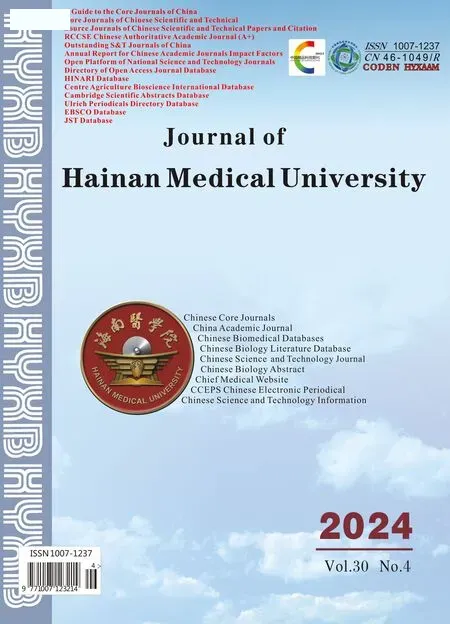 Journal of Hainan Medical College2024年4期
Journal of Hainan Medical College2024年4期
- Journal of Hainan Medical College的其它文章
- Advances of lncRNA MAFG-AS1 in cancer
- Research progress on dynamic monitoring of ctDNA and drug resistance related concomitant mutations in non-small cell lung cancer
- Prognostic characterization of copper death-related immune checkpoint genes and analysis of immunologic and pharmacologic therapy in bladder cancer
- Recent research progress from biological perspective on the mechanism of formation of osteoarthritis after anterior cruciate ligament injury
- Meta-analysis of the efficacy and safety of Bushen Huoxue decoction in the treatment of Osteoporosis
- Sequential experimental observation on the curative effect of Yingbupu decoction of Zhuang medicine on stage I and II acute kidney injury
